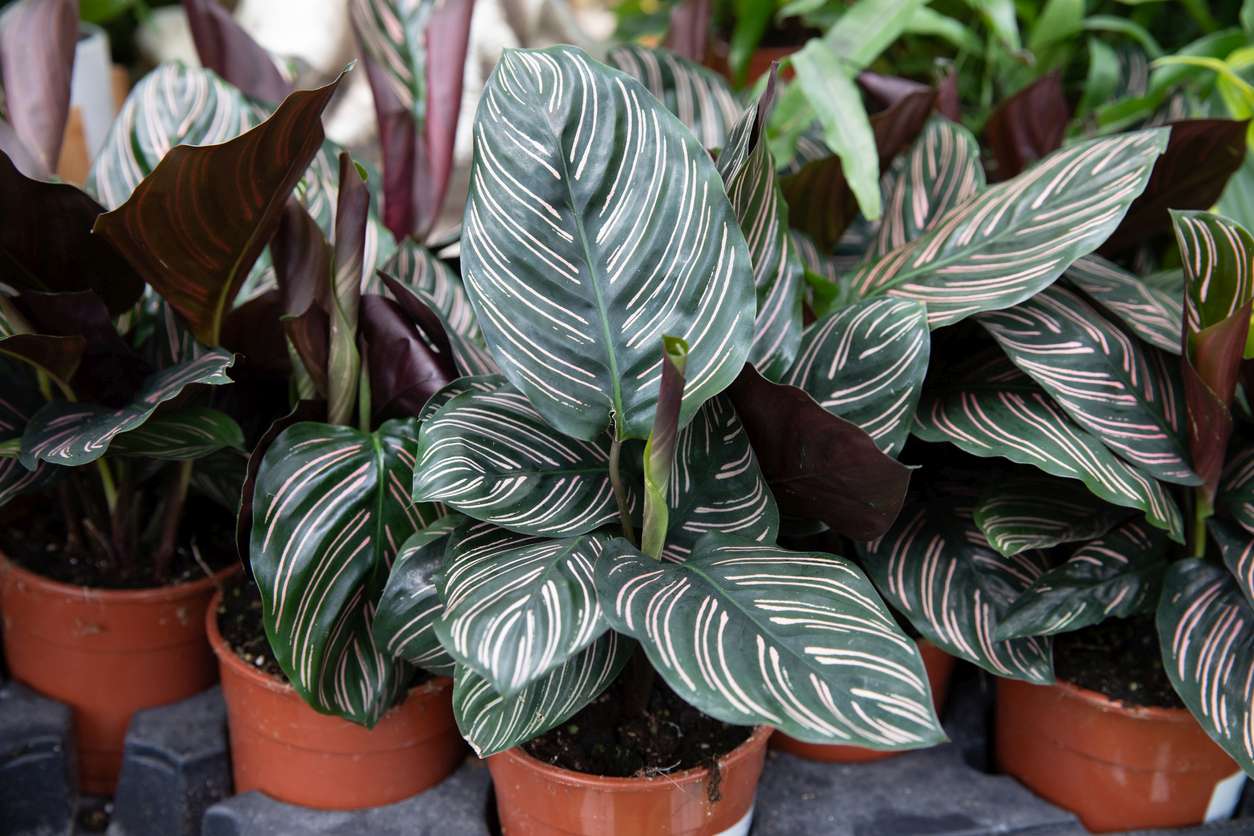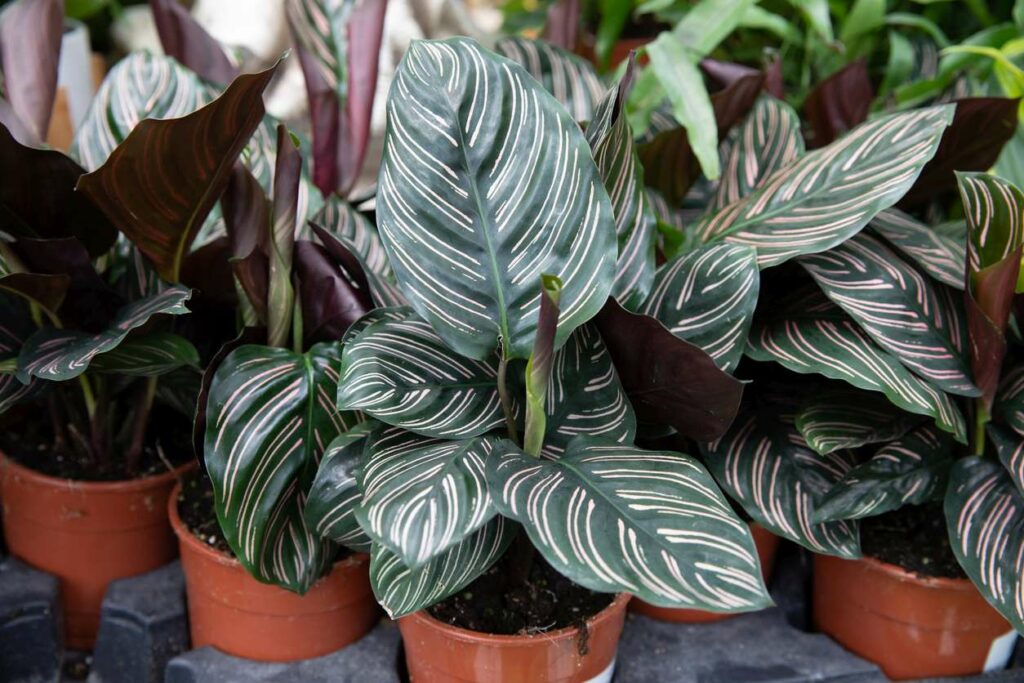Calathea Plant Care: Tips For Growing Calathea Plants
The tropical Calathea is an exquisite plant that you can grow both indoors and outdoors. However, indoors, either as an office plant or in your house, it seems to do much better than if you grow it in the garden. Apart from their ornamental values, Calathea plants do a great job cleaning up the air, absorbing carbon dioxide, and trapping the dust with their large waxy leaves. They also improve the humidity in the place protecting you and your family against dry skin and respiratory diseases.
The Calathea is one of those plants that when you take care of them, they pay you back dividends. So let’s see how you can grow and care for the Calathea.
Calathea Plant at a Glance
The oblong leaves of the Calathea are probably the first thing that gets your attention. The markings on the dark green leaves are almost hypnotic. It’s no wonder the Calathea is a popular plant around offices and in many living rooms. It comes in different colors and has a calming effect that fits in many settings.
A native of the tropical forests of South America, the Calathea is a perennial plant known by many other names. Among them, the rattlesnake plant, zebra plant, and peacock plant are the most common. Fully mature, the plant reaches about 3 feet in height and 2 feet in width. This means you can practically place them on a window sill if you like or even as the centerpiece on a table in the living room.
Calathea plants can grow outdoors if you have the right weather conditions. In Hawaii and the Florida Panhandle, people often grow it in pots in their garden without any issues. When the weather gets cold, they move them indoors.
Calathea Plant Varieties
Naturally, you’d always want to have a different Calathea than the one your neighbor has in their house or the one your coworker grows in their office. The good news is you have over 300 species of Calathea plants to choose from. Each has its own set of patterns, markings, and color schemes. However, not all those varieties are available in your local nursery or even online. Some are rare species that only grow in special horticultural labs. Here are the common ones.
- Calathea Zebrina: Commonly known as the zebra plant thanks to the patterns on the leaves that look like zebra stripes. The leaves are usually dark green and the stripes are white. Add to that some purplish hues on the underside of the leaves to complement the color carnival.
- Calathea Makoyana: This one gets the name, peacock plant, from its showy colors and broad patterns. Even though it shares the same color scheme as the zebra plants, the colors here are much brighter and the patterns much larger.
- Calathea Ornata: The femme fatale, as it is known, is a departure from the other two varieties not just in the patterns on the leaves but the coloring as well. Here pink is the prevailing shade and the markings are thinner with veins criss crossing the whole length and breadth of the leaf. However, it’s not easy to grow and care for.
- Calathea Crocata: This species gets its name, the eternal flame, not from the special patterns on its leaves or unique color combinations. It’s the orange flower that blooms every year that makes it really dazzle as a tropical plant. The leaves themselves are rather plain and won’t get your attention one way or the other.
How to Grow Calathea Plant
So far we have talked about the benefits of growing the Calathea as a houseplant or one that adorns your office. But did you know that you could also plant it in your garden? Here we’ll cover both indoor and outdoor growing of the Calathea plant.
Indoor Calathea
This is the most convenient way to grow Calathea since you have more control over the weather, light, and humidity levels. The steps are rather simple.
- Pick a spot in your house or office that gets plenty of light but isn’t exposed to the direct sun rays. A window sill will do or even a table in the middle of the room.
- Choose a medium pot with lots of drainage holes at the bottom.
- Fill the pot with a good potting mix. Any commercial potting mix will do, although you can mix soil with peat and worm compost in equal portions to create your own.
- Make a hole in the soil twice as deep as the size of the root ball and a little bit wider.
- Remove the Calathea from the pot it came in and check the roots. Remove any damaged, rotten, or entangled roots.
- Lower the plant in the hole and fill it with soil. Tap the soil gently around the roots to make sure the plant can stand upright on its own.
- Water the pot thoroughly until the water flows out of the drainage holes at the bottom.
- Keep the soil moist in the early stages until the roots establish.
- Use a fertilizer once every two weeks to keep those lush leaves growing and looking their best.
Calathea in the Garden
Even though the process is almost identical, growing Calathea outdoors means you have to pay attention to the weather and things like shade and whether the sun will cover the plant or not.
- Choose a spot that doesn’t get direct sunlight but still is flooded with light. In the shade of a tree is ideal since that’s similar to the natural habitat of the Calathea.
- Break the soil with a hoe to loosen it up and add a 3-inch thick layer of organic compost. Mix well.
- Make a hole in the soil twice as deep and wide as the height and width of the root ball of the plant and place it into it.
- Fill the hole with soil and pack it gently.
- Water the soil until it’s thoroughly wet to help the roots settle.
- Add a thick layer of mulch to improve soil aeration and water retention. The mulch will take longer to break offering slow-release fertilizer to enrich the soil.
- Water the soil once a week. If it’s hot and the soil goes dry fast, you can water it twice a week.
Calathea Plant Care
Calathea care is a little bit more complex than growing it. That’s understandable. So let’s get to the maintenance part and see how you can take care of the Calathea plant and keep it growing successfully.
Light
The best type of light for this tropical plant is a filtered one. Direct sunlight hurts the leaves while dim light doesn’t encourage its growth either. If you place it on a window sill that gets a lot of sunlight, consider using a thin curtain to shield the plant from the glare. If you grow it outdoors, then in the shade of a tree sounds like the right spot for your Calathea.
Water
How much water your Calathea needs depend on whether you grow it indoors or outdoors and what time of the year it is. Indoors, where the temperature is mostly stable and controlled, you won’t need to water it more than once a week during the summer and even less when the weather gets cooler. Outdoors, it’s a different story. The summer heat makes the soil go dry faster and the Calathea plant is a thirsty plant. So try to keep the soil moist but not wet. Wait for it to go dry before you water it again. But don’t let it go dry for long otherwise the leaves will droop and wilt away.
Humidity
Warmth and humidity are key factors in the success of the Calathea. As natives of Brazil and the Amazon Rainforest, they’re used to high levels of moisture in the air and warm temperature. It’s one of the reasons that growing the Calathea indoors is often preferred over planting it in the garden. However, if the plant is near a heat vent and you feel there’s not enough humidity in the room or office, you can mist it with a spray bottle once every couple of days. Make sure to spray it in the morning so that the water will have time to evaporate without causing problems such as fungal infestation.
Pests and Diseases
Luckily, the waxy leaves of the Calathea attract dust and absorb carbon dioxide but that’s all they attract. Pests and bugs don’t find the thick leaves particularly juicy so they leave it alone. The usual aphids and mealybugs stay clear. Except for the fungus gnats. These tiny bugs can make a really big mess and cause serious damage to the otherwise healthy leaves. They are attracted to the wet soil. So hold the watering and spraying for a while until the soil goes dry.
The other issue you might have is the brown leaf tips disease. It’s often caused by low levels of humidity. Spray the plant more often with water making sure it goes dry during the day and not pile up on the leaves and cause a fungal infestation.

